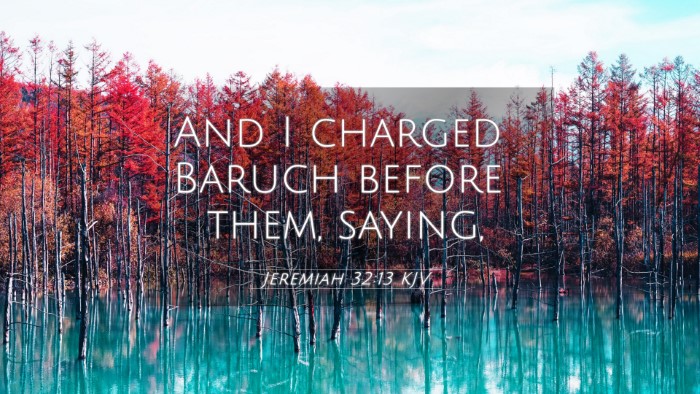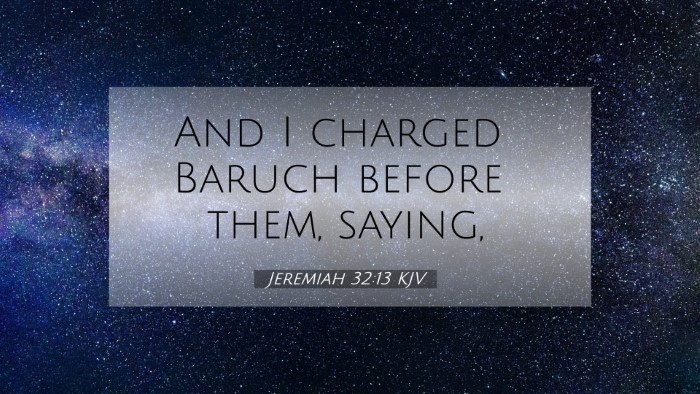Understanding Jeremiah 32:13
In Jeremiah 32:13, the prophet Jeremiah is instructed by God to communicate the significance of the purchase of a field in Anathoth as a symbolic act, demonstrating God's faithfulness to His covenant with Israel, even in the face of impending judgment. This verse encapsulates themes of hope and restoration amidst despair.
Verse Context
This verse appears during a time when Jerusalem is under siege by the Babylonians. The purchase of the field serves as a prophetic symbol of future restoration, showcasing God's promise that the people of Israel will return to their land. Matthew Henry comments on this context, explaining that Jeremiah's actions illustrate his faith in God's promises despite the current circumstances.
Key Themes
- Faith in Adversity: Jeremiah's obedience to God's command to buy a field in a time of desolation signifies unwavering faith.
- Divine Promise: This act represents the assurance of return and restoration for the people of Israel.
- God’s Sovereignty: It emphasizes God’s control over historical events and His ultimate plan for His people.
Cross References
To fully understand Jeremiah 32:13, we can explore several Bible cross-references that enhance our comprehension of its themes:
- Leviticus 25:23-24 - Explains the principle of land ownership in Israel, linking to God’s promise to His people.
- Isaiah 54:10 - Illustrates God's unfailing compassion and commitment to Israel, reinforcing hope amidst turmoil.
- Ezekiel 37:21-22 - A prophetic promise of unity and restoration for Israel serves as a thematic connection.
- Romans 11:1-2 - Discusses God’s enduring relationship with Israel, affirming His covenant faithfulness.
- Hebrews 11:1-2 - Highlights faith as the assurance of things hoped for, resonating with Jeremiah's act.
- Matthew 1:12 - The genealogical ties to the promise of land through David connects directly with Jeremiah's context.
- Revelation 21:2 - Envisions the ultimate fulfillment of God's promises through a new creation, echoing themes seen in Jeremiah.
Interpretative Insights from Commentaries
Gathering insights from Matthew Henry, Albert Barnes, and Adam Clarke, we can further discern the depth of Jeremiah 32:13:
-
Matthew Henry: He emphasizes Jeremiah's foresight in purchasing the land to assure the people of God's promise of future restoration and the continuity of His covenant.
-
Albert Barnes: He notes that Jeremiah's actions serve as a dramatic confirmation of God’s intentions for Israel, highlighting the balance between judgment and hope.
-
Adam Clarke: He underscores the prophetic nature of the land purchase while affirming the permanence of God’s promise in the face of human despair.
Themes in Comparative Analysis
This verse, when compared with others, reveals a rich tapestry of hope and restoration in the scriptural narrative:
- Hope during Judgment: Similar to Jeremiah 29:11, where God assures Israel of His plans for their welfare, contrasting their current reality.
- Restoration Promises: Ezekiel 36:24-28 echoes the new covenant, expressing a profound transformation that ties back to the assurances found in Jeremiah.
- Covenant Faithfulness: References in Deuteronomy 30:1-5 depict the restoration of Israel as contingent on their repentance, resembling themes in Jeremiah.
Conclusion
Jeremiah 32:13 serves as a powerful reminder of God's unwavering faithfulness and the hope found in His promises, particularly in times of distress. By employing tools for Bible cross-referencing and studying comparative scripture, we gain profound insights into the interconnected nature of God's Word. This verse calls us to trust in God's sovereign plan and to find assurance in His promises, underscored by the various cross-referenced themes throughout Scripture.


